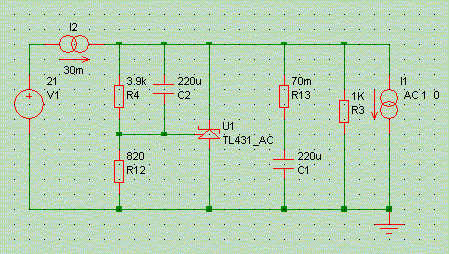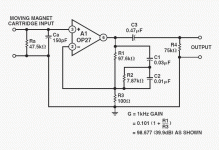Am in the process of building a phono stage like Gary Pimm has made...in the meantime I want to throw together a little op amp RIAA amp, just for kicks but also as a reality check.
The requirements are..
I have 2 TLE2027 AI opamps that I want to use, I'm not going to buy OPA627's or any other opamp.
So I found attached schematic in some datasheet. Any suggestions for improvement/alterations?
The requirements are..
I have 2 TLE2027 AI opamps that I want to use, I'm not going to buy OPA627's or any other opamp.
So I found attached schematic in some datasheet. Any suggestions for improvement/alterations?
Attachments
Nuvistor! What a great link...it even has a low z option for Grado...I happen to have a Grado!
Thanks so much... I also have a pair of 5532...would that be better than an TLE2027 (OP27) in the application for a Grado cartridge?
Thanks so much... I also have a pair of 5532...would that be better than an TLE2027 (OP27) in the application for a Grado cartridge?
I have used a buffer for this type of low load but if your requitrements are "medium" I think the circuit you have shown will work but it's good to use a rather fast opamp because you want to apply some feedback also.
100 ohm pure resistive load isn't a problem to most opamps. You haven't got exactly any voltage over it in normal frequencies.
Bas, if you haven't seen my two RIAA amps you may check them out.
100 ohm pure resistive load isn't a problem to most opamps. You haven't got exactly any voltage over it in normal frequencies.
Bas, if you haven't seen my two RIAA amps you may check them out.
Bas, if you haven't seen my two RIAA amps you may check them out.
Hi Per, I have...but they are too complicated for me! 😉
Regards,
Bas
The Xc of 0.03uf and 0.01uf in series is 100 ohms at 133kHz, so all is well for audio, I'm more concerned about what happens if incidental pickup from an AM radio station gets amplified. The 100 ohms is high enough to prevent op amp instability due to the feedback network capacitive load.
This thread is a discussion of the VSPS.
This thread is a discussion of the VSPS.
You can remove the "complicated" stuff and take the rest. I'll recommend you to download the datasheet for the LT1115. There you have a passive RIAA, almost the same as Mr. Jung has present in his very thick and good book from Analog Devices.Bas Horneman said:Hi Per, I have...but they are too complicated for me! 😉
I good pcb will help. Both my pcb's with groundplanes have also place holders for RF filters.nuvistor said:I'm more concerned about what happens if incidental pickup from an AM radio station gets amplified.
I am using the VSPS and can highly recommend it, don't know how it compares to other circuits, but for such a simple circuit it produces excellent results. I am using OPA627's (free samples). I added switchable loading network to the front end.
Shoog
Shoog
The simplest RIAA op amp circuit uses 1 OPA, active RIAA is the best approach using 1 modern OPA. Passive RIAA requires at least 2 and perhaps 3 OPAs for enough gain to overcome RIAA network insertion loss with good overload margin. Simplest is best for someone who just wants to throw something together.
A comparison between a VSPS-type and the Pimm would be interesting, my wager is on the Pimm having more low-level detail and better perceived dynamics, and the VSPS measuring better for noise and distortion, assuming both are built carefully and with good quality passive components.
A comparison between a VSPS-type and the Pimm would be interesting, my wager is on the Pimm having more low-level detail and better perceived dynamics, and the VSPS measuring better for noise and distortion, assuming both are built carefully and with good quality passive components.
VSPS-type and the Pimm would be interesting
Yes..I'm curious too! 🙂 My Pimm (many made that stage what it is today) will be fitted with cascaded dn2540 mosfets...and will have a few russian teflon caps.
I'm thinking ...for the psu ..could I stack 2 of

Good to hear Shoog!I am using the VSPS and can highly recommend it,
Thanks again...I just read the whole thing 🙂This thread is a discussion of the VSPS.
Bas, your shunt regulator looks fine, TL431 is within ratings. But if you want something simple why not use 3-terminal regs like LM317/337?
It's TNT audio'sBas, your shunt regulator looks fine,
Yeah..you are right....I get carried away almost automatically. I think I'm going to stick with the 78(9)15's. Can always build a shunt reg later ...to compare.But if you want something simple why not use 3-terminal regs like LM317/337?
peranders said:I think the circuit you have shown will work but it's good to use a rather fast opamp because you want to apply some feedback also.
That's not a major concern because the beauty of this arrangement is that loop gain remains virtually constant across the audio band (well almost). A GBP of around 10 MHz will suffice. But the higher the GBP the higher the loop gain available, that’s true 😉
An externally hosted image should be here but it was not working when we last tested it.
Finished the VSPS! Used an OPA2134 because I could not find my NE5532..
Turned out very ugly...but sounds good enough...only difference is I used 78/915
An externally hosted image should be here but it was not working when we last tested it.
I used styroflex caps for the RIAA part...and used 4 little 1uF polyprops per channel .... that I got from Jens Rasmussen for the crossover boards...MOX.
And added little 4,7uF decoupling caps near the power pins.
And added little 4,7uF decoupling caps near the power pins.

How is 50Hz hum pickup? I always end up with a shielded box, with input connector grounds isolated from box and input ground connected to amplifier input ground, in this case junction of R1 and R2.
I should have suggested that you try batteries for power, but I'm used to building tube phono circuits where that's not practical.

How is 50Hz hum pickup? I always end up with a shielded box,
It's relatively noisy...but not a real bother....can't hear it when the music is playing...only with no music and volume turned up max..I might rebuild it one day..and do a proper job...and put it in a proper box.
Thanks again for pointing me in the VSPS direction.
PS. just goes to show that anything can hum if you don't do it properly, tubes or solidstate. 😀
Mine hums slightly two, at high volumes- not so you would notice with music playing. I set mine up so that the capacitors were scaled down by a factor of 10x, as per a comments by Thorsteon. I also have a very high gain- such that it plays about twice as loud as my CD player !! A bit of a mistake really.
Have you got any other circuits to compare it to, especially tube circuits.
My next project will probably be Thorsteons simple tube phone amp.
Nice to see you got yours running, but your right - a terrible mess.
Shoog
Have you got any other circuits to compare it to, especially tube circuits.
My next project will probably be Thorsteons simple tube phone amp.
Nice to see you got yours running, but your right - a terrible mess.
Shoog
When using batteries to power a phono pre like the vsps wouldn't it be an issue if there are differences between the +/- voltages?
Let's say it's running on (2) 9v batteries and one of them got drained faster before the other. Like one reads 8.5 volts and the other 7.5 volts.
Let's say it's running on (2) 9v batteries and one of them got drained faster before the other. Like one reads 8.5 volts and the other 7.5 volts.
- Status
- Not open for further replies.
- Home
- Source & Line
- Analogue Source
- RIAA stage, with certain requirements..
